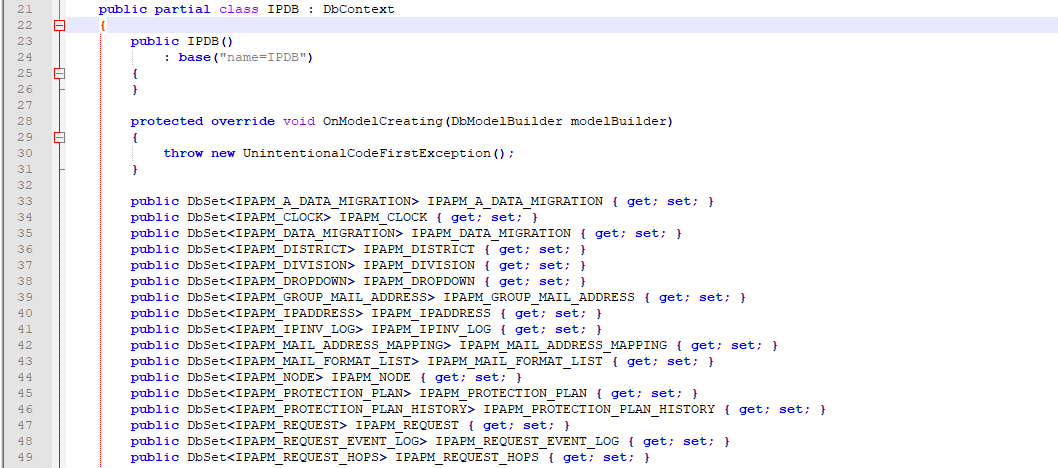An ASP.NET web project, connecting to an Oracle database using entity framework DB first or EDMX was working great with its production schema. Unexpectedly, it wasn't working with the newly created test schema. But finally, with some changes, we were able to get things running.
Background
It was an ASP.NET .NET Framework 4.5 project using EntityFramework 6.0.0 generated EDMX from an Oracle database schema. Things were working great with the production schema, but unexpectedly, it wasn't connecting/working with the newly created/production-replicated test schema.
Db Context Class
The Db context was very basic as shown below:

Production Connection String
Production schema name: IPWAVE
<connectionStrings>
<add name="IPDB"
connectionString="metadata=res://*/EntityDataModels.IPAddressPlannaing.csdl|
res://*/EntityDataModels.IPAddressPlannaing.ssdl|res://*/
EntityDataModels.IPAddressPlannaing.msl;provider=Oracle.ManagedDataAccess.Client;
provider connection string="DATA SOURCE=xx.xx.xx.xx:xxxx/yyyyyy;
PASSWORD=SecretThing;USER ID=IPWAVE"" providerName="System.Data.EntityClient" />
</connectionStrings>
Change Connection String
At Web.config, we changed database connection string from production to test, new test schema name: IPWAVETEST.
<connectionStrings>
<add name="IPDB" connectionString="metadata=res://*/EntityDataModels.
IPAddressPlannaing.csdl|res://*/EntityDataModels.IPAddressPlannaing.ssdl|
res://*/EntityDataModels.IPAddressPlannaing.msl;provider=Oracle.ManagedDataAccess.Client;
provider connection string="DATA SOURCE=xx.xx.xx.xx:xxxx/yyyyyy;
PASSWORD=SecretThing;USER ID=IPWAVETEST"" providerName="System.Data.EntityClient"/>
</connectionStrings>
As we can see, the schema names were different.
- Production schema name:
IPWAVE - New test schema name:
IPWAVETEST
After changing the connection string, we ran the application but it was throwing exceptions.
Why Wasn't It Working?
Entity Framework Generated SQL Not Working With New Schema
After debugging, we found the connection established without any issue but Linq or Lambda Expression not working with the DbContext due to entity framework generated SQL. The SQL was including old schema name like:
SELECT * FROM "IPWAVE"."IPAPM_CLOCK"
Where the expected query was:
SELECT * FROM "IPWAVETEST"."IPAPM_CLOCK"
EDMX Hardcoded Schema Name
The SQL generation module of an Entity Framework provider translates a given query command tree into a single SQL depending on the configuration. In our case, EDMX file DbModelContext.edmx was previously auto-generated from Db, contained all the mapping configurations including hardcoded schema name IPWAVE inside it.
Here is the screenshot of the schema binding section of the EDMX file.

Possible Solutions
- Change schema name sections of the EDMX file manually each time, while switching from one schema to another
- Manage things dynamically, depending on connection string provided schema name
Manage Things Dynamically
To manage things dynamically, we need to:
- Update existing
EntityFramework - Create a custom Db Command Interceptor, which will replace the old schema name with a new one for SQL query
- Use the custom Db Command Interceptor with current
DbContext
Update EntityFramework
We have to upgrade EntityFramework 6.0.0 to EntityFramework 6.2.0 or later to use Db Command Interceptor option. This upgrade may add new things to the current web.config file.
="1.0"="utf-8"
<packages>
<package id="EntityFramework" version="6.2.0" targetFramework="net45" />
</packages>
Db Command Interceptor
This class will replace oldSchema name with the newSchema name, before the query reaches the database.
using System.Data.Entity.Infrastructure.Interception;
namespace IPAPM.EntityDataModels
{
class ReplaceSchemaInterceptor : IDbCommandInterceptor
{
private readonly string _oldSchema;
private readonly string _newSchema;
public ReplaceSchemaInterceptor(string oldSchema, string newSchema)
{
_oldSchema = Schema(oldSchema);
_newSchema = Schema(newSchema);
}
public string Schema(string schema)
{
string value = string.Format(@"""{0}"".", schema);
return value;
}
public void NonQueryExecuted(System.Data.Common.DbCommand command,
DbCommandInterceptionContext<int> interceptionContext)
{
}
public void NonQueryExecuting(System.Data.Common.DbCommand command,
DbCommandInterceptionContext<int> interceptionContext)
{
command.CommandText = command.CommandText.Replace(_oldSchema, _newSchema);
}
public void ReaderExecuted(System.Data.Common.DbCommand command,
DbCommandInterceptionContext<System.Data.Common.DbDataReader> interceptionContext)
{
}
public void ReaderExecuting(System.Data.Common.DbCommand command,
DbCommandInterceptionContext<System.Data.Common.DbDataReader> interceptionContext)
{
command.CommandText = command.CommandText.Replace(_oldSchema, _newSchema);
}
public void ScalarExecuted(System.Data.Common.DbCommand command,
DbCommandInterceptionContext<object> interceptionContext)
{
}
public void ScalarExecuting(System.Data.Common.DbCommand command,
DbCommandInterceptionContext<object> interceptionContext)
{
command.CommandText = command.CommandText.Replace(_oldSchema, _newSchema);
}
}
}
Things may need to change depending on needs, so please check string Schema(string schema) method.
Use Db Command Interceptor With DbContext
The schema name switching is going to take place inside the constructor.
private const string _edmxDefaultSchema = "IPWAVE"; EDMX hardcoded schema namestring schemaValue Expected schema name from the connection stringpublic readonly string Schema; The actual schema that will be used to generate SQL
namespace IPAPM.EntityDataModels
{
using Oracle.ManagedDataAccess.Client;
using System;
using System.Configuration;
using System.Data.Entity;
using System.Data.Entity.Core.EntityClient;
using System.Data.Entity.Infrastructure;
using System.Data.Entity.Infrastructure.Interception;
using System.Data.SqlClient;
public partial class IPDB : DbContext
{
private const string _edmxDefaultSchema = "IPWAVE";
public readonly string Schema;
public IPDB()
: base("name=IPDB")
{
string conString = ConfigurationManager.ConnectionStrings["IPDB"].ToString();
EntityConnectionStringBuilder entityConnectionStringBuilder =
new EntityConnectionStringBuilder(conString);
OracleConnectionStringBuilder details =
new OracleConnectionStringBuilder
(entityConnectionStringBuilder.ProviderConnectionString);
string schemaValue = details.UserID;
if (!schemaValue.Equals(_edmxDefaultSchema,
StringComparison.InvariantCultureIgnoreCase))
{
Schema = schemaValue;
DbInterception.Add(new ReplaceSchemaInterceptor(_edmxDefaultSchema, Schema));
}
else
{
Schema = _edmxDefaultSchema;
}
}
}
}
Using the DbContext
Linq or Lambda Expression
Linq or Lambda expression usages will be same as regular:
IPDB Db = new IPDB();
IPAPM_USER user = (from b in Db.IPAPM_USER
where b.USER_NAME == userName
where b.STATUS == "Active"
select b).FirstOrDefault();
Raw SQL Query
While using any raw SQL query, we are including the schema name in our query. At the new DB context class, we have a schema property (public readonly string Schema).
IPDB Db = new IPDB();
List<string> values = Db.Database.SqlQuery<string>
(String.Format("SELECT ColumnName FROM {0}.TableOrViewName", Db.Schema)).ToList();
References
Limitations
- In our target DB, all objects belonged to the same schema (
USER ID=IPWAVE) - Have tested things with:
- Entity add/update/delete (DB row insert/update/delete)
- Execute raw SQL query with EDMX/Entity Framework
- Haven't worked with:
- Migrations: EDMX changes to Db
- EDMX refresh: Db changes to EDMX
History
- 4th June, 2020: Initial version
